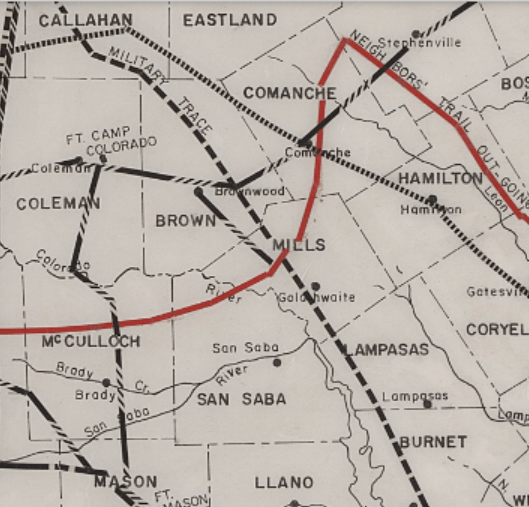
Sometimes a road might actually be the oldest historical object around, but old roads don’t often get much credit for their history. They can’t be displayed in a museum, and are often hard to accurately trace and notice, which I guess makes them less directly engaging to the imagination than relics you can see clearly and touch. Nevertheless, some of our early roads frequently carried Native American hunters and adventurous settlers to their destinations, sometimes safely and sometimes not. The roads did, however, always carry stories.
One such old road (although I cannot trace it back to Native Americans) is deeply interwoven with the development of Brown County and surrounding areas. Once known as Wire Road because the telegraph line ran along it, Williams Ranch Road was also part of the military road system in the early days of the county.
Wikipedia tells us: “Williams Ranch, established in 1855 in Brown County [now Mills], was the first community that developed into a large, dynamic town after establishing trade with Mexico and serving as a major center for cattle business, capitalizing on its location near the Western Cattle Trail. The town served as the “headquarters” of the West Texas frontier and was expected to serve as the county seat. “Old Fort Phantom Hill Road,” the only military route that crossed Mills County, passed through Williams Ranch, connecting Austin and Fort Phantom Hill, located north of Abilene. In 1876, a telegraph line was built along the road, later to be known as the “Wire Road.”
Local resident Frank Griffin, whose grandparents used to own a wagon yard beside the crossing at Pecan Bayou near Williams Ranch, remembers his grandfather telling him about Wire Road. “I am fairly certain from both printed and oral sources that the military road between Austin and Camp Colorado was the road going up the east side of the Pecan Bayou. It would have crossed the Colorado below the confluence of the Pecan Bayou, and would not have crossed the Bayou until it was in Brown County.;[…] The early written accounts say that Welcome Chandler and other early settlers followed the road from Austin, and then settled on the east side of the Bayou,’ Griffin told me. “The military road went through Williams Ranch to Lampasas and on to Austin. My mother’s father (who was the first child born in Mullin), took us down the old road all the way to Williams Ranch many years ago. It followed county roads for the most part, but he pointed out where you could see it in pastures.”
The February 17th, 1977 Edition of the Goldthwaite Eagle referred to Wire Road’s historical significance: “Part of the old Chesser Valley community is now occupied by the maneuvering area from Camp Bowie at Brownwood. Camp Bowie officials have also repaired and used part of the Old Wire Road, which ran through Chesser Valley and Williams Ranch. The Wire Road was so named because it was the trail worn during the building of the first telegraph line through this country from Austin to Fort Concho, now San Angelo.” The same publication, on June 16, 1977 again mentions the road. “After Texas gained its independence, a number of military forts were established along the western frontier and one of them was called Fort Phantom Hill, located near Abilene. The military fort had to be supplied, so a trail or road was built from San Antonio to Fort Phantom Hill–this road was sometimes called ‘The Wire Road.”
Williams Ranch Road follows the old telegraph line pretty closely, according to Griffin, and according to my research was also used by the stagecoach lines en route to Brownwood and further north. The telegraph poles have disappeared, but the road still remains. “The poles were what is called ‘pencil cedar’, and dad told me that they were cut down after WWII to make plaques for mounting longhorn horns,” Griffin said. The telegraph poles were long gone from within Brownwood, but I read (long ago) that they followed Coggin Avenue and Chapel Hill Road. Bryan Healer lived out that way and said some of the poles still stood in his lifetime.”
Old roads are drivable relics. Along this route, you can nearly see a spinster aunt, peeking out of the stagecoach window as she descends upon unwary relatives in Brownwood, or an angry sheriff chasing a drunk cowboy out of town. There is a lot more to the story from out that way, which perhaps we can get to another time, but it must occasionally have been, back in the day, one heck of wild ride, as another extract from the Eagle describes, “…the land of Williams Ranch, where cattle roamed, churches were formed, mobs were born, men died with their boots on; where the Wire Road ran and life was not safe for any man.”
***
Diane Adams is a local journalist whose columns appear Thursdays on BrownwoodNews.com
